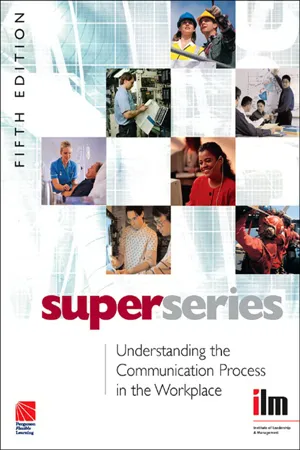Direction of Communication
Direction of communication refers to the flow of information within an organization, encompassing upward, downward, and lateral communication. Upward communication involves messages from employees to managers, while downward communication involves messages from managers to employees. Lateral communication occurs between individuals or groups at the same hierarchical level. Effective management of these communication directions is crucial for maintaining a well-informed and cohesive business environment.
7 Key excerpts on "Direction of Communication"
- Vibrant Publishers, Callie Daum(Authors)
- 2020(Publication Date)
- Vibrant Publishers(Publisher)
...Communication Effective communication skills are vitally important in every industry and workplace. Every day you communicate with colleagues, executives, customers, leadership, and team members. It’s even more critical today when everything is digitalized and communicated through technology. First, communication happens in two directions – downward and upward. Downward communication is when a manager communicates to employees. Upward communication occurs when the employees communicate to managers Or when managers communicate upward to other managers. Communication Process What happens during communication? In its simplest form, a sender sends a message through a channel of communication to a receiver or receivers. The sender is responsible for putting the message into a format easily understandable by the receiver. The receiver deciphers the message, so they can understand the meaning and importance. Understanding the communication allows you to minimize misunderstandings and overcome barriers at any stage of the process. The way you choose to communicate is known as the channel. Examples of a channel may be social media, text, phone call, face to face, email, radio, television, written documents, reports, etc. Choosing the correct channel of communication is critical to an effective message. For example, if you need to get a message out to a large group of people about a change in a policy, utilizing a phone tree (where one person calls another with the info) would not be appropriate because information could become misconstrued during the relay. Messages must be put into a format that can be communicated with the channel chosen for that particular message. Thoughts will need to be translated into sentences for messages sent through emails and reports. For a brief announcement or commercial, the message would need to be abbreviated. As you are thinking about what form you will use for your message, consider the audience...
- eBook - ePub
- Michele Kehoe(Author)
- 2013(Publication Date)
- Gill Books(Publisher)
...This is particularly true in companies that fail to conduct regular performance appraisals. The lack of this type of information impacts directly on the level of job satisfaction experienced by employees. Upward communication This is the flow of information from the lower levels of the organisation to the upper levels. It normally consists of information managers need to perform their jobs, such as feedback about the status of lower-level operations, which could include reports of production output or information about any difficulties experienced by employees. The upward flow of information is essential for managers in order to make important work-related decisions. In addition, upward communication can consist of complaints and suggestions for improvement from lower-level workers and is significant because it gives subordinates some involvement in the functioning of the organisation. Lateral communication This is the flow of messages between people who are on the same level in an organisation and is especially important when co-workers have to co-ordinate their activities in order to achieve a goal as part of a team or task force. Lateral communication can also occur between cross-departmental committees, for example between the sales, production and quality control departments. Lateral communication facilitates the sharing of news and information and helps develop interpersonal relationships. 11.5 Enhancing communication in organisations Several strategies can be used to enhance the flow of communication in organisations. Employee suggestion schemes – Workers can submit ideas in a variety of ways and can be encouraged by some sort of incentive or bonus scheme based on the amount of savings the suggestion produces...
- eBook - ePub
Corporate Communication
A Marketing Viewpoint
- Klement Podnar(Author)
- 2014(Publication Date)
- Routledge(Publisher)
...An integrated and holistic approach to all communication produced by an entity (such as organization); a synchronization of different aspects of communications by an entity and the integration of messages that this entity is sending to its audiences through its behaviour, symbols and messages. It is an umbrella term for all forms of behaviour and communication that are performed (within or outside) by a certain corpus. Business communication. Applied science dealing with the construction and application of modes of expression, symbols and signs that accompany profit-oriented activities, related to offering products and services for satisfying human needs and desires. Organizational communication. Focuses on analytical and critical capabilities that enable the interpersonal, collective and total understanding of the organization through a communication perspective. The main focus of the discipline is studying vertical, horizontal and transversal information flows in an organization. Management communication. Combines the knowledge of business and organizational communications and transfers it to the management context. This discipline tries to explain structural, systemic and functional aspects of communications and to provide knowledge of communication techniques among managers in the internal and external environment of the organization. Public relations. A discipline and a management function that deals with planning, execution and evaluation of organizational communications with internal and external publics, or with managing communications between an organization and its strategic stakeholders. Marketing communications. This is an instrument aimed at involving consumers in an exchange relationship with an organization. Each marketing communication is target-oriented in the sense that it directly or indirectly supports the selling of the product, service and/or any other brand. Duality of organization...
- eBook - ePub
Solutions
Business Problem Solving
- Frank Fletcher, Eric Bolland, Eric Bolland(Authors)
- 2016(Publication Date)
- Routledge(Publisher)
...CHAPTER 4 Communications KAREN CLANCY and LINDA ELDRIDGE Effective communication is essential to business strategy and success. Without it, companies cannot prosper. Communication forges important linkages between the mission and goals of an organization and its internal and external constituents. Successful managers must develop effective communication skills and processes to exchange information and build linkages with important stakeholders such as customers, workers, suppliers, distributors, financiers, boards, communities and many others. Written, verbal and non-verbal communications are at the heart of effective information exchanges but there are often many barriers and challenges. This chapter is dedicated to identifying the most common communication problems that managers face and to providing solutions to each. Specific problems are identified and diagnosed, and a set of possible alternatives is offered so the reader can quickly and effectively arrive at a solution. What are the basic components and common barriers of business communication? Have you ever had difficulty understanding someone? Was the meaning of the message difficult to interpret? Or, have you felt like people just didn’t understand your messages? Examining the basic steps of a specific communication process enables you to identify potential barriers or diagnose existing ones. Analyzing and preparing a communication transaction helps to avoid misunderstandings, misalignment of resources and loss of productivity. Let’s review the basic components of a communication transaction. The communication process involves senders, messages and receivers. That sounds simple enough. However, upon closer examination, there are many factors that influence senders, messages and receivers. These influences often determine the effectiveness of the information exchange and ultimately impact the outcome of the communication transaction process...
- eBook - ePub
- John Brinkman, Ilve Navarro, Donna Harper(Authors)
- 2014(Publication Date)
- Routledge(Publisher)
...5 Communicating across the functions ‘The greatest problem in communication is the illusion that it has been accomplished.’ (George Bernard Shaw) Chapter Outline 5.1 Introduction 5.2 What is communication? 5.3 Functions of communication 5.4 Flow of communication 5.5 Challenges to effective communication 5.6 The impact of technology on communication 5.7 Summary Chapter Objectives After carefully reading and engaging with the tasks and activities outlined in this chapter, you should have a better understanding of: • what communication is • the function of communication within organisations • the variety of ways in which communication occurs in the organisational context • some of the barriers to effective communication • some of the impacts that technology has had on communication in organisations. 5.1 Introduction In this chapter we will largely focus on internal communication within organisations, although we will briefly touch on communication between organisations when we consider technology and communication. Without effective internal communication, no one will know what is really going on, and serious problems can arise, particularly in terms of control, coordination, and the negative impact it can have on employees. Information can get lost somewhere in ‘the system’: it can be distorted, misunderstood, and so on. Being able to communicate effectively both within and across the functions of an organisation is therefore of vital importance. Key Terms Internal communication is communication that occurs within an organisation, as opposed to between an organisation and individuals and companies outside of the organisation. 5.2 What is communication? Many people think the answer to this question is simple and straightforward. However, as can be the case with many words we use every day, it is a little more complicated than most people realise. Some people make the assumption that communication is purely the transmission of information...
- Institute of Leadership & Management(Author)
- 2013(Publication Date)
- Routledge(Publisher)
...Session A The communication process 1 Introduction Have you ever followed a political coup in the media? Did you notice that the first thing those involved want to do is to gain control of television and radio stations and national newspapers? Then they can control how information is communicated to foes, friends – and probably most importantly, potential friends who may join their side. It’s all about communication, and making communication work in your favour. Communication is used to change public opinion, or what consumers buy. It is a large part of the activity of many organizations which employ communication directors, public relations executives and media consultants whose job, basically, is to put their organization’s point of view across in the most favourable light possible. Media studies courses are among the most popular choices for a degree, given the career opportunities that they present. This is really nothing new. Managers of organizations at all levels have always had to communicate – with employees, customers, shareholders, suppliers. Indeed, there are often legal requirements to do so, as with the publishing of annual reports to shareholders, price lists to customers and safety notices to employees. When we communicate with our work team we normally want to get them to do something. It is very important though to explain why you want them to do things, to help gain their trust and commitment to what is needed. So how can we communicate effectively with our teams, and what happens if we don’t? 2 The importance of communicating effectively at work 1 The manager of a baker’s shop rang the bakery, 40 miles away, in despair. That morning she had received 50 expensive special order products which she did not usually stock. She had specifically ordered 15 when placing her telephone order the day before...
- eBook - ePub
The Strategic Communication Imperative
For Mid- and Long-Term Issues Management
- James Mahoney(Author)
- 2021(Publication Date)
- Routledge(Publisher)
...Communication practitioners are guided by technical definitions and accepted processes and communication strategy, or plan, structures (see for example, Cutlip et al., 2006; Gregory, 2009; Mahoney, 2013; Seitel, 2011; Wilcox & Cameron, 2012; Wilson & Ogden, 2008). Seitel (2011) viewed strategic communication planning as an essential part of management. Wilson and Ogden (2008) argued that strategy is a well-coordinated approach to reaching an overall goal and that communication is strategic when it helps an organisation to accomplish overall goals in a consistent manner. Wilson (2001) noted that being strategic in communication practice means contributing to achieving an organisation’s mission and goals and systematically planning with them in mind. Wilcox and Cameron (2012) said that systematic strategic planning prevents haphazard, ineffective communication. This strategic function requires close alignment with key organisational leaders, meaning that public relations, for example, should take on a more strategic role (McDonald & Hebbani, 2011). Strategic planning includes coordinating activities and fine-tuning messages to maximise effectiveness (Lauer, 2001). A consistent theme in the literature about the role of communication in supporting organisational goals and objectives has been that it should be aligned with, and reflect, an organisation’s strategic business plan, or corporate strategy (see, for example, Argenti et al., 2005; Cornelissen, 2005; Gregory, 2009; Jones & Bartlett, 2009; Mahoney, 2013). J.E. Grunig and Repper, for example, dealt with such an alignment in 1992 in their commentary on the Excellence Study; J.E. Grunig (2009) returned to the theme in the context of applying social media to public relations practice and how this would enhance his concept of two-way symmetrical communication...






